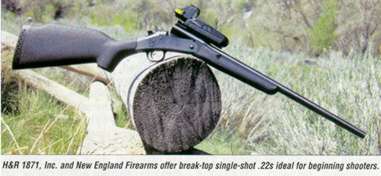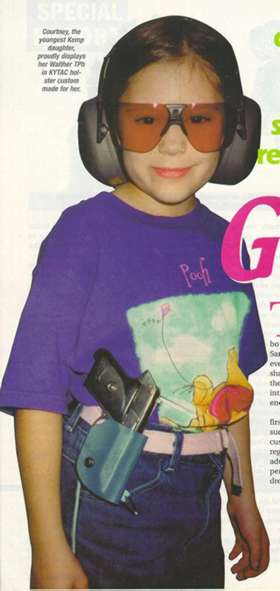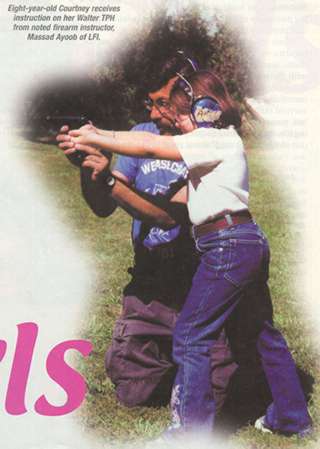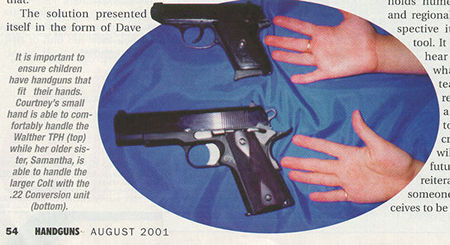| |
"A .22 For Christmas"How
the Gun Industry Designs and Markets Firearms for Children and Youth"Sized
for the Next Generation" In
May 2000, Brian C. Sheetz, Associate Editor of the NRA's American Rifleman
magazine declared, "Nowadays, no parent has to settle for anything less than a
youth-specific first firearm. A fine-quality lineup of youth long guns specifically
designed and marketed for smaller shooters is available from main-line and specialty
firearms manufacturers."7 Sheetz
offered a definition for the youth gun: Exactly
what is a youth-specific long gun? While no hard-and-fast definition exists, the
key thing to look for is a firearm that will make shooting safe and enjoyable
for the beginner. Some youth guns are simply abbreviated versions of their adult
counterparts while others are proportionally scaled-down designs that would be
as inappropriate for an adult shooter as an adult gun is for a slightly built
youngster.8 Firearms
designed specifically for children and youth tend to be rifles or shotguns. There
are several reasons for the lack of youth-specific handguns— - The
larger size of typical long guns make them more difficult for children to carry.
Handguns are easier for children's smaller hands to grip, as Andy Kemp noted with
regard to his eight-year-old daughter, "Courtney's small hand is able to comfortably
handle the Walther TPH while her older sister, Samantha, is able to handle the
larger Colt with the .22 Conversion unit."9 As a result, children can
simply use smaller, "adult" handguns.
- Federal
law prohibits handgun possession by juveniles with several exceptions. On the
other hand, while long guns cannot be purchased by those under 18 years
of age from a licensed dealer, there are no federal restrictions on juvenile long
gun possession.
- Even
some pro-gun writers see the dangers of arming children with handguns. As Clair
Rees explained in Handguns magazine, "Handguns and very young shooters
are a poor combination. When they're excited, it's too easy for youthful handgunners
to point that short barrel in the wrong direction."10



"A
.22 For Christmas," SHOT Business, November 2001, pp. 20-22.
Despite the lack of models
designed exclusively for young shooters, the firearms industry and gun lobby aggressively
market handguns to children—
- The
NRA youth magazine for junior members InSights routinely carries ads for
firearms, including the Harrington & Richardson 929 Sidekick revolver.
- The United
States Practical Shooting Association (USPSA),c actively recruits children
to join its ranks. The organization's Junior Program features a web site "Dedicated
to America's Finest Youth."11 Wally Arida, one-time publisher of the
magazine GunGames, dedicated to combat shooting, stresses, "We must involve
our children into [sic] our gun games. As an industry, we must build the structure
for various youth shooting programs."12
- The
Single Action Shooting Society recruits kids for its "Cowboy Action shooting"
events. Cowboy Action shooters dress up like "wild west" cowboys and shoot at
targets over a course designed to approximate the look and feel of the old west.
As explained in the NRA youth magazine InSights, "The horses are made of
wood and the bandits are silhouette targets, but the spirit of this fast growing
shooting discipline is as true to the Old West as you can get."13 Cowboy
Action shooting requires the use of both handguns and long guns, and the minimum
age is 12 years old.
- The
NRA offers a marksmanship qualification program for handgun and long gun shooting.
According to the NRA's web site, "The NRA Marksmanship Qualification Shooting
is perfect [for] people of all ages—children and adults." Courses offered include
handgun, shotgun, light rifle, and high-power rifle qualification.14



"Girls and Guns,"
Handgus, August 2001, pp.50-54.
c)
"Practical shooting" is a euphemism for combat shooting, an event where competitors
conduct their activities over a "run-and-gun" obstacle course where they face
a variety of "real-world" shoot/don't shoot situations, such as firing at the
human silhouette of a "hostage-taker" while sparing the "hostage." For more information
on "practical shooting," see Josh Sugarmann and Philip Alpers, Gold Medal Gunslingers:
Combat Shooting Targets the Olympic Games (Washington, DC: Violence Policy
Center, 1999)
Back
to Table of Contents
All contents
© 2001 Violence Policy Center
The Violence Policy Center is a
national non-profit educational foundation that conducts research on violence
in America and works to develop violence-reduction policies and proposals. The
Center examines the role of firearms in America, conducts research on firearms
violence, and explores new ways to decrease firearm-related death and injury.
|